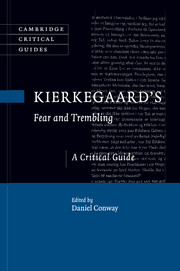Book contents
- Frontmatter
- Contents
- List of Contributors
- Acknowledgments
- List of Abbreviations
- Introduction
- Chapter 1 Homing in on Fear and Trembling
- Chapter 2 Fear and Trembling’s “Attunement” as midrash
- Chapter 3 Johannes de silentio’s dilemma
- Chapter 4 Can an admirer of silentio’s Abraham consistently believe that child sacrifice is forbidden?
- Chapter 5 Eschatological faith and repetition: Kierkegaard’s Abraham and Job
- Chapter 6 The existential dimension of faith
- Chapter 7 Learning to hope: the role of hope in Fear and Trembling
- Chapter 8 On being moved and hearing voices: passion and religious experience in Fear and Trembling
- Chapter 9 Birth, love, and hybridity: Fear and Trembling and the Symposium
- Chapter 10 Narrative unity and the moment of crisis in Fear and Trembling
- Chapter 11 Particularity and ethical attunement: situating Problema III
- Chapter 12 ‘He speaks in tongues’: hearing the truth of Abraham’s words of faith
- Chapter 13 Why Moriah?: weaning and the trauma of transcendence in Kierkegaard’s Fear and Trembling
- Bibliography
- Index
- References
Chapter 3 - Johannes de silentio’s dilemma
Published online by Cambridge University Press: 05 February 2015
- Frontmatter
- Contents
- List of Contributors
- Acknowledgments
- List of Abbreviations
- Introduction
- Chapter 1 Homing in on Fear and Trembling
- Chapter 2 Fear and Trembling’s “Attunement” as midrash
- Chapter 3 Johannes de silentio’s dilemma
- Chapter 4 Can an admirer of silentio’s Abraham consistently believe that child sacrifice is forbidden?
- Chapter 5 Eschatological faith and repetition: Kierkegaard’s Abraham and Job
- Chapter 6 The existential dimension of faith
- Chapter 7 Learning to hope: the role of hope in Fear and Trembling
- Chapter 8 On being moved and hearing voices: passion and religious experience in Fear and Trembling
- Chapter 9 Birth, love, and hybridity: Fear and Trembling and the Symposium
- Chapter 10 Narrative unity and the moment of crisis in Fear and Trembling
- Chapter 11 Particularity and ethical attunement: situating Problema III
- Chapter 12 ‘He speaks in tongues’: hearing the truth of Abraham’s words of faith
- Chapter 13 Why Moriah?: weaning and the trauma of transcendence in Kierkegaard’s Fear and Trembling
- Bibliography
- Index
- References
Summary
Each of the three ‘Problems’ in Fear and Trembling culminates in a dilemma:
(I) During the time before the outcome, either Abraham was a murderer at every moment or we are at a paradox that is higher than all mediations. (FT 58/SKS 4, 159)
(II) Either there is an absolute duty to God . . . — or else faith has never existed because it has always existed, or else Abraham is lost. (FT 71/SKS 4, 171)
(III) Either there is a paradox, that the single individual as the single particular stands in an absolute relation to the absolute, or Abraham is lost. (FT 106/SKS 4, 207)
In each case it seems that Kierkegaard’s pseudonym, Johannes de silentio, is attempting to persuade the reader to accept the alternative that involves paradox and an ‘absolute duty’ to God, and thereby accommodates Abraham. Perhaps for this reason the dilemmatic form of the conclusions to the ‘Problems’ is usually assumed to be merely rhetorical, and given little attention. But attending more closely to Johannes de silentio’s dilemma helps to illuminate Fear and Trembling in its historical context, and to clarify how the analysis of Genesis 22 offered in this text differs radically from earlier interpretations.
‘Either/or’: Kierkegaard’s critique of Hegelian theology
The dilemmatic form ‘either … or’ signals the immediate intellectual background to Kierkegaard’s early work. It echoes, of course, the title of his first major pseudonymous work: Either/Or was published a few months before Fear and Trembling, in February 1843, and supposedly written by different authors. But this title itself echoes earlier references to ‘either/or,’ notably in texts by two prominent Danish theologians: Bishop Jakob Peter Mynster and Hans Lassen Martensen. Kierkegaard had a personal connection to both men as well as an interest in their theological work. As Chaplain to Vor Frue Kirke in Copenhagen, Mynster was parish priest to the Kierkegaard family; Søren Kierkegaard heard Mynster preach countless times, and learned much from the bishop about the nature of Christian communication. Kierkegaard was certainly acquainted with Martensen by 1834, for in this year he engaged the theologian – then a junior lecturer in the Teologiske Fakultet at the University of Copenhagen – to give him tutorials on Schleiermacher’s The Christian Faith.
- Type
- Chapter
- Information
- Kierkegaard's Fear and TremblingA Critical Guide, pp. 44 - 60Publisher: Cambridge University PressPrint publication year: 2015
References
- 1
- Cited by



